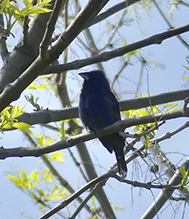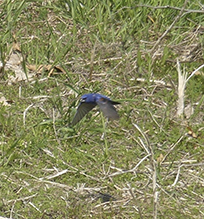Blue Grosbeak
(Passerina caerulea)
Conservation • Description • Habitat • Ecology • Distribution • Taxonomy
Conservation Status |
|||
| IUCN Red List | LC - Least Concern |
||
| NatureServe | N5B - Secure Breeding SNRB - Unranked Breeding |
||
| Minnesota | not listed |
||
Description
Male upper parts and underparts are deep blue. The bill is large, cone-shaped, and pale gray. There is black aroud the base of the bill. The wings are black with two rusty wing bars. The female is brown with a white throat, rusty wing bars, a small blue patch on the shoulder, and a blue wash on the rump.
Size
Total length: 6″ to 7½″
Wingspan: 11″
Voice
The song is a rich, musical, warble, with notes that rise and fall, lasting 2 to 3 seconds.
Similar Species
Indigo Bunting (Passerina cyanea) is smaller. There are no wing bars. The bill is much smaller.
Habitat
Areas with thick shrubs, scattered trees, and open areas; riparian woodlands, weedy old fields.
Ecology
Migration
Nesting
Nests in dense tangle in a low bush or tree, 4 to 13 feet off the ground, often at the edge of an opening.
Food
Mostly insects, but also spiders, seeds, and fruits. Occasionally visits feeders.
Distribution
Occurrence
Rare migrant and breeder
The nesting range of this species barely extends into the southwest corner of Minnesota, with accidental sightings east to the Twin Cities metro area. The range is expanding northward and eastward, possibly due to warming climate.
Maps
The Minnesota Ornithologists’ Union All Seasons Species Occurrence Map
Taxonomy
Class
Aves (birds)
Order
Passeriformes (perching birds)
Family
Cardinalidae (cardinals and allies)
Genus
Passerina (North American buntings)
Genus
This species was originally (1758) named by Linnaeus Coccothraustes caerulea. In 1886 the American Ornithologists’ Union (AOU) named it Loxia caerulea. In 1998 the AOU transferred it to a monotypic genus and it became Guiraca caerulea. Mitochondrial DNA analysis in 2001 showed that it belongs in the genus with the buntings, and in 2002 it became Passerina caerulea.
Subordinate Taxa
Blue Grosbeak (Passerina caerulea deltarhyncha)
Blue Grosbeak (Passerina caerulea eurhyncha)
Blue Grosbeak (Passerina caerulea interfusa)
Blue Grosbeak (Passerina caerulea lazula)
Chiapas Blue Grosbeak (Passerina caerulea chiapensis)
Eastern Blue Grosbeak (Passerina caerulea caerulea) ![]()
Western Blue Grosbeak (Passerina caerulea salicaria)
Synonyms
Guiraca caerulea
Loxia caerulea
Visitor Photos
Share your photo of this bird.
This button not working for you?
Simply email us at info@MinnesotaSeasons.com.
Attach one or more photos and, if you like, a caption.
Jonathan Strandjord |
||
 |
 |
|
MinnesotaSeasons.com Photos
|
|

Slideshows
Blue Grosbeak
Allen Chartier
Blue Grosbeak
JMC Nature Photos

Visitor Videos
Share your video of this bird.
This button not working for you?
Simply email us at info@MinnesotaSeasons.com.
Attach a video, a YouTube link, or a cloud storage link.
Other Videos
Burung Master : Kicauan Merdu Burung Blue Grosbeak (Passerina Caerulea)
Kicau Burung
Blue Grosbeak - Cape May, New Jersey
Greg Gard
Blue Grosbeak, Koll Center Wetlands (Oregon), 29 April 2015
Cyanocitta2
Blue Grosbeak Singing
Into The Wild
Blue Grosbeak
Jan Dolphijn


